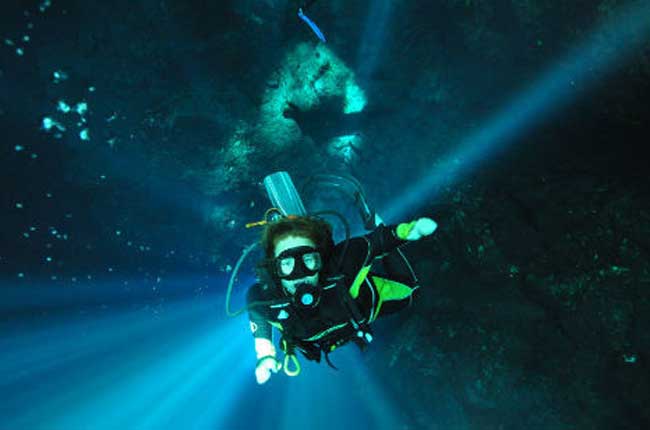
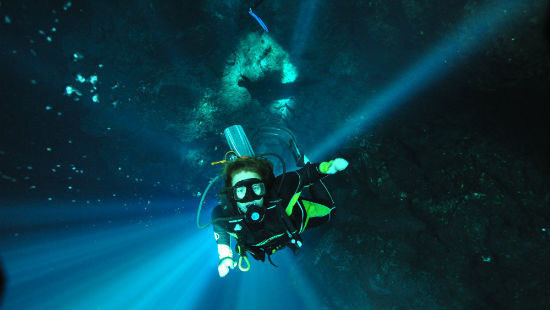
Life Appreciation Recipe:
- 4 parts diving in a unique natural phenomenon
- 1 part snorkeling with giant sea turtles
- 1 part salsa dance lessons next to the beach
- 2 heaping servings salty ceviche
- 1 serving octopus in garlic butter
- 1 Australian dive master
- Dash sunburn
Directions: Head to the Yucatan Peninsula in Mexico. Combine all ingredients with sand. Mix until blended and enjoy for four days, or as long as humanly possible. Pair with cold Mexican beer on the beach at sunset.
***
Diving in the Yucatan
After my first dive in Tulum with my friend Nicole, we surfaced from the underground cavern and she asked me if I liked it.
“There was just one problem,” I told her. “You forgot to show me how to sign, ‘this ROCKS’.”
You see, when you’re wearing a regulator (the scuba mask that lets you breathe out of the tanks on your back) it is impossible to talk. You must settle for a very limited spectrum of hand signals, such as “Ok,” (ok hand signal), “Air at 1000,” (holding up 1 finger) “Hey, I need your attention,” (waving your flashlight quickly back and forth), “Look,” (pointing at your eyes, then at the item) and “Get me OUT of here,” (Thumbs up sign).
Nicole, like a good dive leader, kept looking back at me during our first dive in the Los Ojos Cenote and asking me if I was ok, and I had to very simply tell her that yes, I was ok. I liken this to the man of your dreams telling you that he won the lottery, then asking you if you are willing to spend the rest of your life with him diving in cenotes or doing whatever you damn well please, and all you’re allowed to do is nod your head once if you accept.
Yes, I will admit that diving is not for everyone, especially diving in cenotes, which are basically underwater caves. However, I would like you to suspend your creepy crawly, there’s-gotta-be-a-monster-in-there claustrophobia for just a moment so I can try, TRY to convey my four dives in Tulum. I say “try” because much like when I was underwater, there are never going to be enough words – or pictures, for that matter – to convey what I found underground.
Cenotes are part of an underground river system on the Yucatan Peninsula. Basically, the roof falls in on these underground caverns, making them accessible from the surface. Depending on how close they are to the ocean, they are a mix of freshwater and salt water, often in layers.
The Dos Ojos Cenote is partially covered: it opens like a cave — it has a roof — and has a pool of clear cold fresh water in it that you can snorkel in without ever really going underground. There are two lines to follow if you’re diving in Dos Ojos: they are red strings strung into the underground caverns from the entrance, and you follow them through stalactites and stalagmites, sometimes with no daylight and only your flashlight to keep you company, and sometimes with sunlight pouring in from various openings, either through the water or through the rock overhead.
This first dive was my first in four years, since the best day of my life diving on the Great Barrier Reef in Australia. I was slightly nervous, but really just more excited about being able to do this with Nicole, who was my roommate when I was a ski instructor in Colorado and had gotten certified the year before to lead people through the cenotes.
I had forgotten what diving felt like: when you’re doing it right, you float at any depth you wish. You can drop inches or feet by simply expelling your breath, and rise up by inhaling. The world I followed her through was dark and shadowed, and I had only my breath for company. I kept craning my neck to see what was around me, which is no small feat when you’re swimming with a tank on your back. When I looked up, I saw our air bubbles gathering in the cracks of the rock overhead and reflecting our lights like tiny shards of broken mirror that slipped and moved from one place to another, looking for an escape.
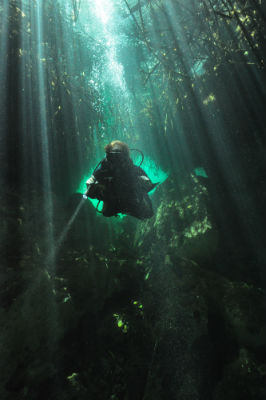
I was free. There was nothing to life but the sound of my own breathing, the small beam of light in front of me, and the shadowed caverns that surrounded me. I felt a swelling in my heart so intense I hardly knew what to do with myself. When the light came in, it was blue, but ALL shades of blue: teals, deep blues and iridescent blues. The fish were transparent when I shone my light on them: their spines glowed green inside their skins.
We surfaced at one point in an underground bat cave, and at the end, out in the open pool but still underwater, we fed the tiny transparent fish with the rotting fruit on the bottom.
You’re supposed to conserve your air while diving by not making unnecessary movements, but at the end of the dive Nicole gave me the go-ahead to do flips since we were almost done and I didn’t need to conserve my air. She must have been able to tell I could hardly stay still, I was so excited with what we’d seen.
Casa Cenote
Casa Cenote was an entirely different experience; to compare them would be useless. This one was open to the sky, and the mangrove tree roots wrapped down into the water like millions of woody fingers. If Dos Ojos was awash with blue, Casa Cenote was a world of different variations of green. Red-green algae coated the floor, the walls, and the rocks, like a red beard that grew long and untamed and undulated with the tide that came from the ocean 50 feet away.
The crabs had bright blue legs and triangle-shaped bodies, and became tenacious in conveying that you were going to be sorry you were in their territory. The caves off to the sides of the cenote were littered with the evidence of passing marine life: tiny tracks snaking through the slime, turtle bones piled behind a rock, slick mangrove roots covered in fungi, animal cocoons and, as always, the swaying algae.
At the bottom of one cave was a halocline layer: where the heavier sea water meets the freshwater, a layer of underwater mist forms. When you’re in it, it looks like you’re straining to see out of a windshield in the pouring rain: like the water is streaking across the world in front of you, and all you need to do was clear your vision.
The Mayans used to believe that the cenotes were an entrance to the underworld, and I believe it: it felt as if the world WAS somewhere far away, and the gateway to another amazing dimension lay on the other side of that cloud.
The next day, we went to The Pit, a cenote deep in the jungle and far away from the sea, snorkelers, and most other people.
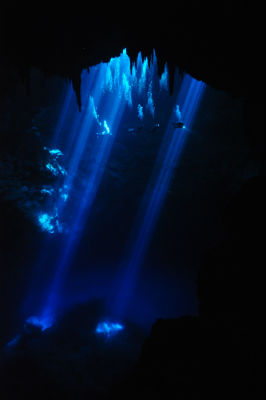
The entrance to The Pit is a relatively small opening – probably 30 feet wide by about 10 feet across – that looks like a rip in the earth’s surface. You have to leap off a 15-foot ledge to get into it, and put on your gear floating on the top of the water.
We hit it just about 10 a.m., after walking in on a rocky road followed by mosquitoes and having our gear brought in by a 19-year-old and his dog on an all-terrain four-wheeler. The sun kept breaking through the canopy and the clouds to illuminate the water, and it shone far down below us – much further than you would think possible from the tiny rip you enter through.
After half an hour of adjusting and fixing gear, we finally began to descend. All of a sudden I realized how big the cavern was: it extended back away from the entrance and down, like we had let ourselves into a huge cathedral through the roof without knowing how far it would be to the floor.
In the other cenotes we were under low hanging roofs. In The Pit, we were floating in the middle of nothing. It must be similar to what you would feel in space, weightless and insignificant, and in the middle of something massive and older than time; The Pit had seen many things and many people, and was unimpressed. Its fish stayed near the surface entrance because that’s where the food was; the rest of the cavern was nothing but clear cold water bathed in blue light.
When I thought we were near the bottom, we reached a halocline layer, and dropped right through it. It was much like passing through a cloud in an airplane, without being surrounded by metal. We could still see the sunlight from the underside, but it was muted, like sunlight didn’t matter to this place.
Nicole led us around the walls while her boss Luis took pictures. They had warned me ahead of time, but it was still amazing when I saw it: a human jaw bone, with two molars still intact, recently confirmed to be from the ice age and possibly the oldest evidence of early man in the area to date. I floated above it in awe, willing myself not to drop on top of it and crush it.
We explored the cave for an hour, slowly working our way up the walls. There was a line of where the water used to reach up to for who knows how many thousands of years, and entrances to other caves off to one side. The Pit was discovered by someone coming IN from exploring another cenote through one of these caves, and I can only imagine the wonder he felt discovering this monstrous well of light.
Once again, I was unable to convey my wonder. I had to hold all my thoughts and excitement inside and try not to let my heartbeat race because it would use up my air. All I could do was breathe, and look around me. I was one of five people in The Pit, but the experience was all my own: I couldn’t share my thoughts with anyone, so they stayed mine and simply grew and expanded until the filled The Pit all by themselves.
I think now it wouldn’t have been as amazing if I could have spoken. The forced silence kept me from distracting myself from sharing my experience with everyone else, and I just got to feel it as it was happening.
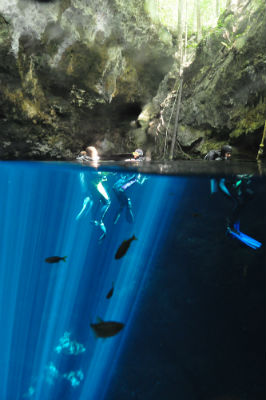
We had gone deep enough that we had to have a decompression stop at the end of the dive – we hung out near the entrance but about 15 feet deep for about 10 minutes, watching the fish surround us and bathing in the underwater sunlight. Every time the light hit me, I felt something akin to disbelief: I don’t know why I was lucky enough to experience this when so many others aren’t, but I wouldn’t trade it for the world.
If You Go
Visit Mexico
www.visitmexico.com
Be sure to go diving in at least a couple different cenotes in the area; they’re all incredibly unique. Consider heading to Akumal to snorkel with the sea turtles. Don’t miss the ceviche in Tulum. The version with octopus is especially delicious. Tell Luis at Dos Ojos Scuba Dive Shop that I said hi!
Author Bio:Morgan Fraser has traveled to more than 20 countries – mostly by herself – and has lived in Spain, Germany, Mexico and Panama. Morgan recently published Confessions of a Travel Addict: Travel Stories from Around the Globe, a collection of short funny travel stories from her time abroad. She is also the author of two regional wine-pairing cookbooks. You can read more about Morgan on her blog, confessionsofatraveladdict.com.
